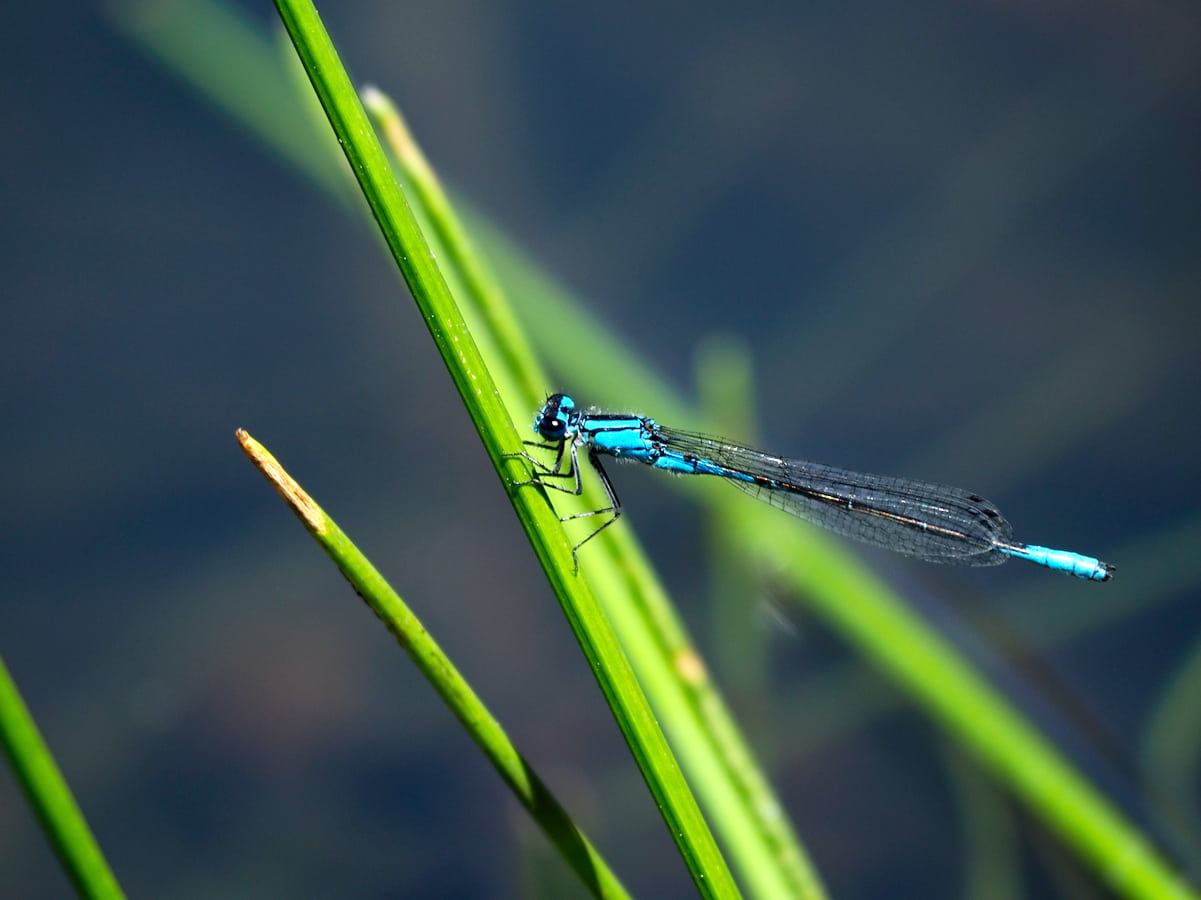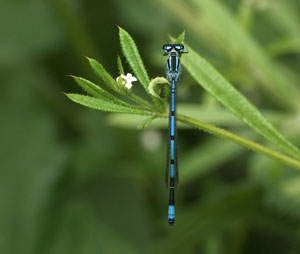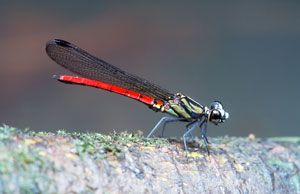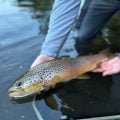“Damselfly Days”

Image by J. Carrol Sain
WHEN RICHARD ROWE was 9 — in the summer of 1957, on holiday in New Zealand — everyone was staring at the sky. They couldn’t help it. They were searching for a sign of Sputnik, necks cranked backward. But the young buck couldn’t take his eyes off the B-52 bugs that were zipping around his parents’ rented beach bungalow. “I was amazed by and frustrated with their amazing power of flight,” he recalls. “And then, in a matter of two hours, a car knocked one down onto the footpath in front of me — and another was caught in a spider web at the house.” The stars must have been aligned. Or maybe the kid just fell for what may well be the orchids of the insect world, delicate, brilliant, mysterious. From then on, Rowe couldn’t forget his encounter with odonata — dragonflies and damselflies — and now studies them at James Cook University in Australia. “I still can’t believe the way that they are able to do all the things they do — with a brain the size of a pinhead.”
But Rowe, though he has friends who are, “mad for the sport,” isn’t an angler. He doesn’t keep 30-gallon aquariums and peer in while his captive nymphs eat every leech and scud in sight. He doesn’t pump stomachs to see what a trout ate for brunch. He doesn’t collect lake-dwelling bugs and ship them to his entomologist cronies. In short, he’s no Philip Rowley. “I got three main weapons when I fish with a damselfly nymph,” says Rowley, the author of Fly Patterns for Stillwaters. “You need an intermediate line, a long leader, and a slow-sinking approach. Oh, and when you’re tying, I keep that pattern skinny! Use some soft rabbit and a couple good ol’ eyeballs. No need to tie on the kitchen sink.”
 Just for a moment, forget about the big four — your mayflies, your caddis, your stoneflies, your midges. What happens when the water slows down? What happens when it’s just you, a float tube, and a lazy July day on the lake? Yes, hatches do burst, explode, turn into events, but what bursts must also fade away — leaving the unglamorous meat-and-potatoes of the trout diet, such presumed snoozes as the scuds and the damselfly nymphs.
Just for a moment, forget about the big four — your mayflies, your caddis, your stoneflies, your midges. What happens when the water slows down? What happens when it’s just you, a float tube, and a lazy July day on the lake? Yes, hatches do burst, explode, turn into events, but what bursts must also fade away — leaving the unglamorous meat-and-potatoes of the trout diet, such presumed snoozes as the scuds and the damselfly nymphs.
Talk to some odonata connoisseurs and you’ll find more than a few blown minds. What’s so great about damselflies? “THEIR SECONDARY GENITALIA — OR MORE PRECISELY, THAT THEIR SPERM-TRANSFER lOGISTICS EVOLVED INTO THIS SEPARATE STORAGE AND TRANSFER ORGAN,” e-mailed Bob Honig, a zoologist, photographer, and all-caps kind of guy in Houston, Texas. Honig’s wife, a biologist named Maggie, sang praises of the “killer lip” — the damselfly nymph’s lightning-fast jaw mechanism that extends a good third of a body length to snag a snack (which sometimes includes small fish or other odonata nymphs).
 Both damselflies and dragonflies are some 300 million years old, and in prehistoric times, had wingspans of 30 inches. (According to one surely legit website, they were “as big as hawks.”) In Germany alone, odonata have had over 150 nicknames — water witch, goddess’ horse, snake killer — and elsewhere, some believed that the Devil used them to weigh a person’s soul. Their true common names are entomological poetry: Powdered Dancer, Citrine, Forktail, Flamehead Sprite, Ebony Jewelwing. The males’ colors push the unnatural end of the natural envelope — stop-sign reds, shining bronzes, iridescent blacks tiger-striped with some of the purest eye-searing turquoise in the animal kingdom.
Both damselflies and dragonflies are some 300 million years old, and in prehistoric times, had wingspans of 30 inches. (According to one surely legit website, they were “as big as hawks.”) In Germany alone, odonata have had over 150 nicknames — water witch, goddess’ horse, snake killer — and elsewhere, some believed that the Devil used them to weigh a person’s soul. Their true common names are entomological poetry: Powdered Dancer, Citrine, Forktail, Flamehead Sprite, Ebony Jewelwing. The males’ colors push the unnatural end of the natural envelope — stop-sign reds, shining bronzes, iridescent blacks tiger-striped with some of the purest eye-searing turquoise in the animal kingdom.
It may be the dragonfly that catches the eye of the everyday human — index finger-long, wings held out like an airplane while at rest, cruising at speeds up to 30 miles per hour and hovering and accelerating and even backing up — but it’s not big in the fish Food Pyramid. The damsel means more to the fisherman. It pays to be able to tell the difference: While at rest, Damsel wings lie flat on their floss-thin abdomens. Their eyes are separated. Don’t tell them, but they suck at flying — and therefore stick close to water. The adult isn’t a major food source for feeding fish, unless a trout bumps it off a reed when it’s emerging and flabby and vulnerable, but the nymph is another story: With three distinctive gills at its hind end, it lies in wait around weed beds in marshes, ponds, and lakes, for prey to swim by. It molts a dozen times and sometimes takes three years to become an adult. “The nymph moves with a sinusoidal motion,” says Rowley, “Snake-like. Stopping, then starting again. Use slow hand-twist retrieves in less than 20 feet of water.” He pauses. “Remember, this is their jungle — where they go stalking.”
And that’s where the angler should go stalking as well: where the water moves slowly, if at all: where long stems arch over the shallows; where the fireworks hatches have come on and gone and the summer sun warms the cold-blooded, as ever, the fish still need to fill their bellies.











